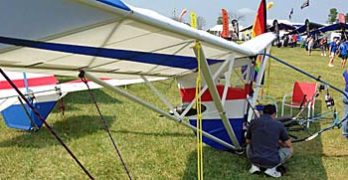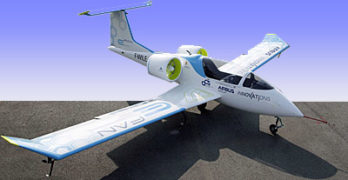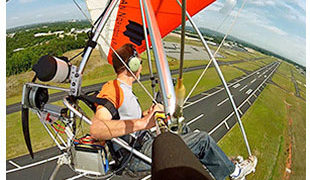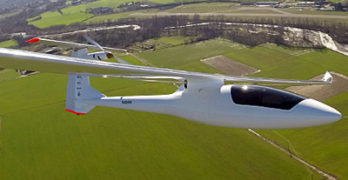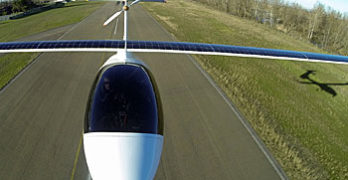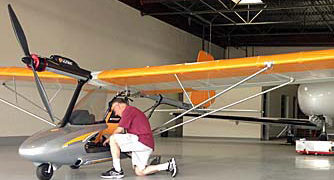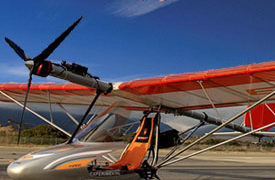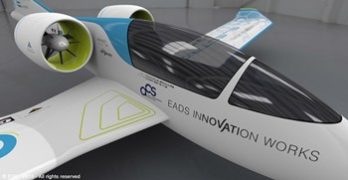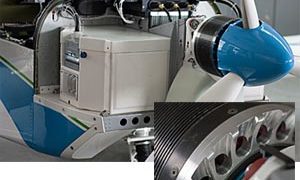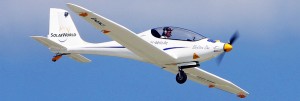Update 8/8/14 — See our video interview about EMG at the end. An unpowered EMG — or Electric Motor Glider — from Adventure Aircraft has already taken 400 flights; it has also been fitted with a small electric motor … complete with carbon folding prop. A new Experimental Amateur Built (EAB) two seater is now taking shape and both variations were on exhibit at AirVenture 2014 in the newly named Fun Fly Zone (formerly Ultralight Area). EMG’s spark is provided by the dynamic duo of Brian and Carol Carpenter of Rainbow Aviation, well known for their LSA maintenance courses including the LSR-M (Light-Sport Repairman Maintenance) credential that has prepared many mechanics to do serious work on the growing fleet of LSA. EMG builder Adventure Aircraft is a subsidiary of Rainbow. Evidently this hard working pair aren’t fond of wasting many hours with something so mundane as sleep because the project is unfolding quite swiftly.
Search Results for : Electric
Not finding exactly what you expected? Try our advanced search option.
Select a manufacturer to go straight to all our content about that manufacturer.
Select an aircraft model to go straight to all our content about that model.
Airbus Goes Electric and Small (with Big Ideas)
As we all get packing for Oshkosh where we’ll see all manner of aircraft, one of the biggest manufacturers revealed one of the smallest airplanes at another airshow: Farnborough in England, an event dominated by military and airline producers. More surprisingly, Airbus announced at Farnborough that it would put into production their all-electric-powered E-Fan. Big aircraft, the buses of the sky, are good at moving people to their destination. However, they are very noisy and consume oceans of fuel leading to more pollution. Can this situation improve? Is it even reasonable to consider an electric-powered airliners? Some experts scoff at the idea but Airbus’ E-Fan made a powerful, if relatively quiet, statement.
Airbus’ E-fan made its first flight at a French airport near Bordeaux on March 11th this year. The project reportedly evolved from work with the tiniest airplane most AirVenture visitors have seen. Airbus used an electric-powered Cri-Cri as a test bed to develop their battery and energy management technology.
Electric Trike Soars (Literally) into Record Book
On Saturday, June 21 with a good crowd watching, an electric-powered trike took off and climbed into the FAI record book, or will after the organization’s normal process is followed. Let me state right up front that this story was recently released on AOPA’s ePilot written by our journalist friend Jim Moore. Despite appearing in the big member organization’s eNewsletter, the story was too cool for me to pass up for ByDanJohnson.com plus, as usual, I have an additional perspective to offer. The images are all courtesy of record-holder-to-be, Gary Davis. If you click the link above you can read Jim’s whole article; I encourage you to do so.
As Jim wrote Gary flipped the switch and flew, “a custom combination of a North Wing Stratus trike wing matched to an electric-powered trike frame designed by Randall Fishman.” We have a number of articles and videos about Randall’s pioneering work.
Sun-Delivered Electric Power on Sunseeker Duo
The developer refers to this long sleek flying maching as, “the first solar powered airplane with a passenger seat.” After his many years of development — longer than other projects that have captured more media attention — Eric Raymond’s Sunseeker Duo may be the most advanced solar powered airplane in the world and … he adds, “the first that might be suited to production.” True, with its 71.5-foot span, this may not be your ideal cross country machine for a family of four. However, soaring enthusiasts should note the resemblance to the top-of-the-line Stemme S10 motorglider. Indeed Sunseeker can soar with the best of them. Electric powered aircraft fans may also want to look closer. For that I direct you to the developer’s website. One more group might also be interested: green tech companies or component suppliers that would like to assist further development while getting themselves some fine publicity.
Sunseeker Duo … Ultimate Solar Electric Aircraft?
Years ago when we were just getting started in our flying careers, one fellow I paid attention to was Eric Raymond. Eric was a very talented hang glider pilot who strove to fly in the highest performing aircraft … at that time the Manta Fledgling, a “fixed wing” hang glider with a category leading glide angle in those days. (Today’s “flex wing” hang gliders significantly surpass the Fledge’.) Eric was also a daring aerobatic hang glider pilot long before most folks knew you could fly a hang glider in that manner. In other words he’s been a leading edge pilot for a long time. In recent years he’s been flying an all electric, solar-boosted glider across Europe. Yet he remained restless, seeking the very most he could do with electric power, which as most readers know, is still in the rapid development, not-quite-ready-for-market stage. Thanks to Flight Design USA boss Tom Peghiny for alerting me to Raymond’s latest progress.
Electric Skyway — Flying GreenWing’s eSpyder
I was a little nervous, I admit. Oh, I wasn’t worried about flying the eSpyder as an airplane. Many years ago I logged plenty of hours in a Flightstar single place ultralight and this was essentially the same airplane. Except it wasn’t identical; this one was powered by an electric motor and it’s funny how that changes everything. Like most of you, I only have experience with gasoline engines (though I have logged many hours of soaring time with no engine whatsoever). So, I have the usual set of knowledge and reflexes about fuel consumption, engine noise, power settings, climb rates … and the sounds of all these things. It’s all different on an electric airplane. Much as I had awaited this opportunity, I found myself apprehensive about the new experience. I’ve had three two-stroke engines go silent on me and I simply didn’t know exactly what to expect from an electric motor.
New Manufacturer of Electric Aircraft
Once upon a time the light aircraft industry announced new manufacturers and models at the rate of two, three, or even more every month …for several years. As with every maturing industry before, this torrid pace had to slow. Yet the party isn’t over, far from it. Contrarily, I am aware of several new projects in the works and we all know of some (Icon, Terrafugia, Lisa among others) where companies have been working on their designs for some years but they have yet to secure FAA approval as a Light-Sport Aircraft. Neither has GreenWing International, a new company announced this week though that may change quickly enough.
“Yuneec International, a world leader in electric power systems, is proud to announce the formation of GreenWing International, [which is] entirely focused on bringing the revolution of electric power to the global general aviation market,” announced company CEO Tian Yu. Enthusiasts following electric powered aircraft development first saw Yuneec’s e430 at AirVenture 2009.
Fantasy in Paris — Electric Twin & More
“How ya gonna keep ‘em down on the farm … after they’ve seen Paree?” That’s a timely reprise of an old show tune to bring our attention to the Paris Air Show, which is sending out some ripples in the “What’s New” Dept. Chances look better every year that electric flight will be a major player in how we take the air. And for those of you who think that’s just a bunch of hot air, you could be right, too! Read on.
Jason Paur who writes for Wired magazine gets to do all the fun stuff I just get to fantasize about … specifically, electric flight. He’s at Le Bourget Field in Paris and filed this report on an exciting new electric prototype that fits nicely into the Light Sport Aircraft specification. Here are some highlights and you can read the rest first hand at the link above.
Electric Avenue Widens; Evektor Motorplane Flies
An “engine” is a machine distinguished from an electric, spring-driven, or hydraulic motor by its use of a fuel, by which most mean gasoline or diesel fuel. An electric powerplant is often referred to as a motor to make it distinct although “motor” is defined as a device that converts any form of energy into mechanical output, which would include engines.
Without fretting over the definition, Evektor flew their new “motorplane” (my word) recently and this post presents our view of this accomplishment. We’ve reported several electric aircraft projects, for example, Yuneec’s Spyder and their larger e430 mentioned in my full-length article on electric aircraft. We’ve also covered Randall Fishman’s ULS (which will be on display in the LSA Mall at Sun ‘n Fun) and several others. To read all our 37 articles of coverage, type “electric aircraft” in the Full-text Search box on our Search page.
Electric Airplane in 48 hours!
With all the bright minds drilling down for electric flight gold worldwide these days, including extensive research into battery storage technology and electric motor development, you’d think it’s only a matter of time before a major aircraft company comes out with an off-the-shelf aircraft to officially “launch” electric flight for the masses.
Yuneec, a Chinese company, did just that a few years back with its graceful E430. Several other companies debuted exciting electric prototypes yet since then, little has manifested under the pilot’s Christmas tree beyond a $200,000-plus electric-sustained sailplane (the elegant Lange Aviation Antares 20E), a composite motorgliderish single-seater that goes for around $140,000 (PC Aero Elektra One) and a two-seat, side-by-side electric powered sailplane (Pipistrel Taurus Electro G2, also available gas powered.)
Of course, we can’t overlook pioneer Randall Fishman‘s efforts.
- « Previous Page
- 1
- …
- 3
- 4
- 5
- 6
- 7
- …
- 67
- Next Page »


